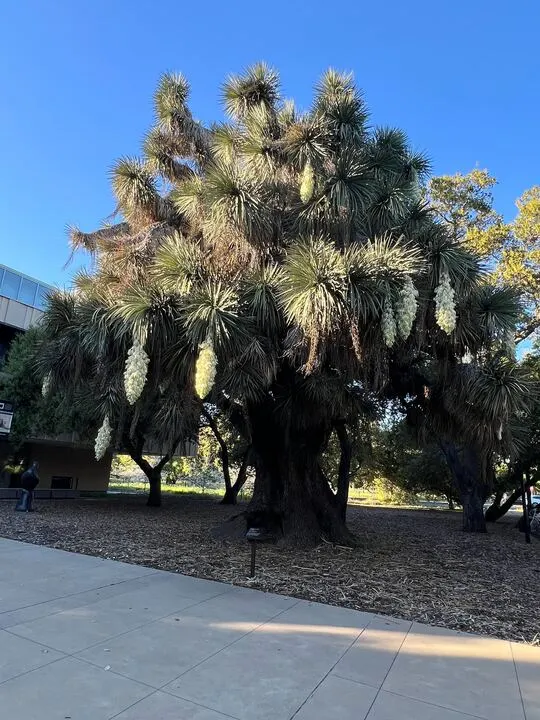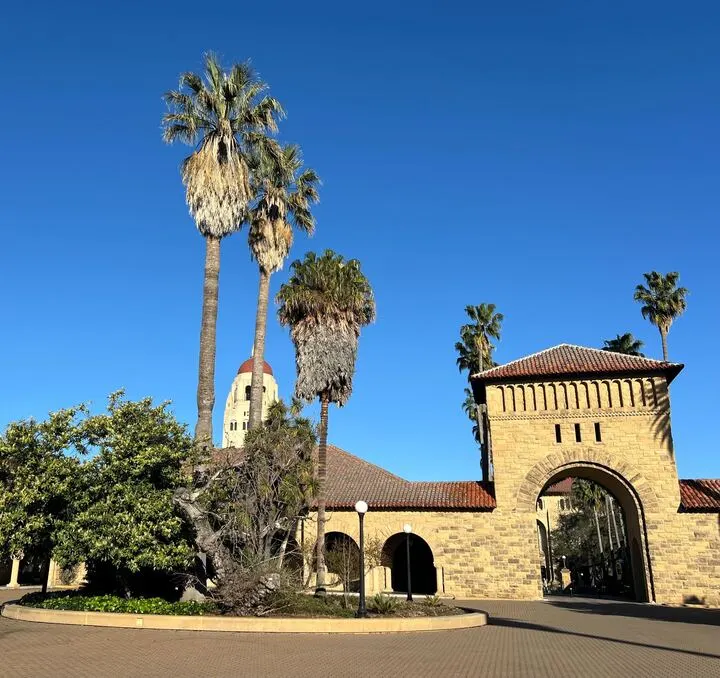Around 43,000 trees and more than a thousand species of plants, from iconic palms to a prize-winning tree yucca, call Stanford’s campus home.
The Daily spoke to several campus tree experts, who shared insights into the secret life of Stanford trees.
Each year, Stanford plants hundreds of new trees, joining the existing thousands that include some that are hundreds of years old, according to Stanford Grounds Manager Michael Gladden. One particularly elderly tree, Gladden said, is the coast live oak located at the corner of Jane Stanford Way and Lasuen Street, which “has been around since the signing of the Constitution.”
The coast live oak species is the most prevalent tree species on campus, with Gladden estimating the trees to make up “50 to 60 percent” of the campus’s total tree population.
Stanford is also home to several rare species of trees, according to Gladden, including the rainbow eucalyptus, whose bark peels to reveal various pastel and sometimes almost fluorescent colors.
The campus also boasts the Torrey Pine, which James Biddle, Tree Program Supervisor at Stanford, wrote is “the rarest pine in the world.” Native only to San Diego, it is now a staple of Californian landscapes, he wrote.
Stanford’s trees are so impressive, that they have even received national recognition. Last fall, Sairus Patel ’91, lead editor of Trees of Stanford, and Biddle submitted the measurements of the tree yucca located in front of the Anderson Art Collection to the California Big Tree Registry. Most American states maintain this registry, Patel said, with size being measured by some combination of height, trunk girth and crown reach at standard height.
The yucca was crowned national winner for being the largest of its species, Patel said.

The prize-winning tree yucca, which won the national title for being the largest of its species. (Photo: SARAYU PAI/The Stanford Daily)
Another unsuspecting winner was a straggly Eucalyptus kruseana tree perched at the corner of Campus Drive and Bonair Siding, which clinched the same title for its species. But the most photographed individual tree on campus, Patel said, is the purple jacaranda in Inner Quad.
One of Stanford’s other most prominent campus trees is the leafy palm tree, including those that line University Avenue. As per campus lore, Stanford’s signature palms cost $70,000 each in annual maintenance, but students who believe in this rumor are barking up the wrong tree. Gladden said that a single palm tree typically sells for $25,000 to $35,000 in the Bay Area, with pruning costs amounting to $2,000 every three to seven years.
Another popular rumor holds that the palm trees are rigged up with a specialized heating system to survive the winter months.
“There is no such heating system, I can confidently put that to rest,” Biddle wrote.
Biddle is part of the Tree Crew, which collaborates with other groups like Landscape Services and the Irrigation Crew to spruce up campus. The team audits tree health across the core campus and faculty housing areas through a grid system, in which “each grid square receives inventory, assessment, and routine tree work every seven years,” wrote Biddle.
Stanford makes conscious efforts at sustainable maintenance across campus. According to Biddle, the University uses rainwater harvesting to irrigate many trees and in certain areas, compost tea in the soil as a pest deterrent for the tussock moth.
Stanford has a deeply rooted history as a sanctuary for trees, according to Patel.
“[Leland Stanford, Sr.] was, as the wife of the University’s first registrar put it, very ‘affectionate towards trees,’ and his preference was that no healthy native oak be removed, wherever possible, when the property was initially being developed,” Patel said.
But tree preservation has frequently been at odds with campus expansion. Patel shared that the University undertook a “complicated construction project” in Building 120 (now McClatchy Hall) in 1979. At the time, the neighboring courtyard was ringed with large avocado trees estimated to be 80 years old. Much to the chagrin of tree-huggers like then-secretary of the Faculty Senate Eric Hutchinson, these trees were at risk of removal.
According to Patel, Hutchinson “actually led a revolt,” and threatened that “when the bulldozers came, [electrical engineering professor Ron Bracewell] would chain himself to the first avocado tree to be bulldozed.”
“Six of those seven trees were spared, and survived for decades, with the last coming down in 2020,” Patel said.
The recent construction of the Manzanita Field Garage led to the loss of some trees. However, the tree crew planted in their stead “a very wide variety of Australian and other trees in the vicinity of EVGR which weren’t very well represented on campus before,” Patel said.
A map made by the Stanford Gleaning Project, a student organization that plucks and donates excess fruit to Bay Area residents in need, indicates it is far from slim pickings when it comes to edible produce on campus, given the presence of citrus and pomegranate trees, along with the famous Tree of 40 Fruits.
For Stanford students intrigued by the trees, tree enthusiast Michael Byun ’24 recommends the Trees of Stanford account on Instagram. In an email to The Daily, Byun wrote that some of his favorite trees on campus include “the silvery Brahea armata fan palm in Main Quad, the eucalyptuses (especially by the Sunken Diamond concession stand)” and El Palo Alto, the thousand-year-old tree that is forever emblazoned on Stanford’s logo.
